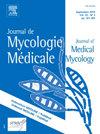Investigation of a dermatophytosis outbreak in a kindergarten in Doubs, France, June 2022
IF 1.8
4区 医学
Q3 MYCOLOGY
引用次数: 0
Abstract
Background
Microsporum audouinii, an anthropophilic dermatophyte has recently reemerged in several European countries (such as France).
Aim
To describe the epidemiological and microbiological investigations into several reported cases of dermatophytosis to the public health authorities in May 2022 in a kindergarten in the Doubs department (eastern France).
Methods
All children with clinical signs underwent a clinical examination and mycological investigation of skin or scalp samples taken onsite at the kindergarten. Several diagnosis methods were used: Wood's lamp examination, classical process (direct examination associated to culture) and molecular techniques. An epidemiological survey by questionnaire was also performed to collect individual exposure data.
Results
Fifteen children presented lesions during the clinical examination. Therapy was prescribed for nine children based on the 2021 recommendations of the French Society of Dermatology. Microsporum canis was initially diagnosed by the classical process. This identification was not confirmed by epidemiological information (absence of direct contact with animals) and molecular techniques. Finally, Microsporum audouinii was isolated in six children (two positive Wood's lamp examinations) and one staff member.
Conclusion
Species identification allowed us to (1) update the therapeutic strategy (all children were treated successfully) and (2) be more vigilant regarding the risk of human-to-human transmissions. The management of intrafamilial transmissions requires collaboration with healthcare practitioners to clinically examine family members, prescribe laboratory investigations, and reiterate the hygiene measures. This study confirmed the importance of combining field epidemiological investigations and microbiological examinations when managing dermatophytosis outbreaks.
2022年6月法国Doubs一幼儿园皮肤真菌病暴发调查
背景audouinimicrosporum audouinii是一种嗜人的皮肤真菌,最近在一些欧洲国家(如法国)重新出现。目的描述2022年5月在杜布省(法国东部)一所幼儿园向公共卫生当局报告的几例皮肤癣病例的流行病学和微生物学调查情况。方法对所有有临床症状的儿童进行临床检查,并在幼儿园现场采集皮肤或头皮标本进行真菌学检查。常用的诊断方法有:木灯法、经典法(与培养相关的直接检查)和分子技术。通过流行病学问卷调查收集个体暴露数据。结果15例患儿在临床检查中出现病变。根据法国皮肤病学会(French Society of Dermatology) 2021年的建议,对9名儿童进行了治疗。犬小孢子虫最初是通过经典方法诊断的。这一鉴定未得到流行病学资料(未与动物直接接触)和分子技术的证实。最后,从6名儿童(2名伍德氏灯检查阳性)和1名工作人员中分离出audouinimicrosporum。结论物种鉴定使我们能够(1)更新治疗策略(所有儿童都得到了成功治疗)和(2)对人际传播的风险更加警惕。家族内传播的管理需要与医疗从业人员合作,对家庭成员进行临床检查,规定实验室调查,并重申卫生措施。本研究证实了现场流行病学调查和微生物学检查相结合在处理皮肤真菌病暴发时的重要性。
本文章由计算机程序翻译,如有差异,请以英文原文为准。
求助全文
约1分钟内获得全文
求助全文
来源期刊
CiteScore
5.10
自引率
2.80%
发文量
68
审稿时长
6-12 weeks
期刊介绍:
The Journal de Mycologie Medicale / Journal of Medical Mycology (JMM) publishes in English works dealing with human and animal mycology. The subjects treated are focused in particular on clinical, diagnostic, epidemiological, immunological, medical, pathological, preventive or therapeutic aspects of mycoses. Also covered are basic aspects linked primarily with morphology (electronic and photonic microscopy), physiology, biochemistry, cellular and molecular biology, immunochemistry, genetics, taxonomy or phylogeny of pathogenic or opportunistic fungi and actinomycetes in humans or animals. Studies of natural products showing inhibitory activity against pathogenic fungi cannot be considered without chemical characterization and identification of the compounds responsible for the inhibitory activity.
JMM publishes (guest) editorials, original articles, reviews (and minireviews), case reports, technical notes, letters to the editor and information. Only clinical cases with real originality (new species, new clinical present action, new geographical localization, etc.), and fully documented (identification methods, results, etc.), will be considered.
Under no circumstances does the journal guarantee publication before the editorial board makes its final decision.
The journal is indexed in the main international databases and is accessible worldwide through the ScienceDirect and ClinicalKey platforms.

 求助内容:
求助内容: 应助结果提醒方式:
应助结果提醒方式:


